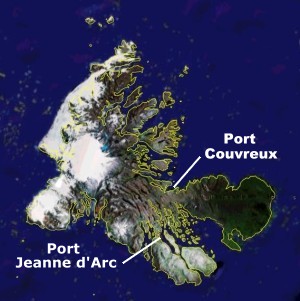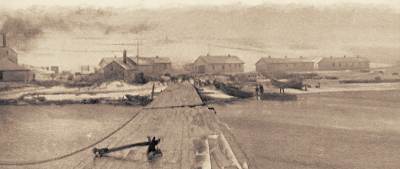
View this page at 1024x768 This page last updated April 2012.
Please contact me for comment or if you can help with extra information.
NEW April 2012.
NEW May 2008.
Port Couvreux - Kerguelen Islands
|
Dependency of France  ------- -------
Images courtesy Google Earth Irvin & Johnson SA & the Kerguelen Islands
Background
In 1908 the Bossiere's were forced to take some action, which resulted in the signing of contracts with two different French concerns, being the brothers Henry & Raymond Rallier du Baty and a Madame Faucon, both conceding rights for the hunting of elephant seals in return for royalties. They also signed an agreement with a Norwegian company, Storm, Bull & Co. who were lured by the prospect of a whaling venture. This agreement was also to provide royalties to the Bossiere's. Soon after the agreement was signed, Storm, Bull & Co. formed a new company, Aktieselskabet Kerguelen, and transferred their rights to it. This company wasted no time in establishing a whaling factory at Port Jeanne d'Arc. One of the Bossiere brothers, Henry, left to visit Kerguelen in late 1908, arriving in early 1909, and upon his return to France published the following article in the magazine 'Illustration'.

The whaling station at Port Jeanne d'Arc 1909 Click to read the 1909 article by Henry Bossiere The profitability of whaling at Port Jeanne d'Arc was very short lived, apparently due to lack of whale stocks. Whaling lasted just three seasons, with elephant seals being hunted in 1912 to enable the oil quota to be reached. In 1913 the Bossiere's formed the 'Compagnie Generale des Iles Kerguelen, Saint Paul & Amsterdam', which landed 1150 sheep at Port Couvreux in August, this venture also being doomed due to the unsuitability of the climate. The onset of The Great War saw the end of any further activity involving Kerguelen until 1919 when Carl Ossian Johnson purchased the A/S Kerguelen from its Norwegian owners.
The Bossiere family were to receive commissions & percentages from Irvin & Johnson as had been the case with the Norwegian owners. Johnson planned to harvest the large population of Kerguelen Islands elephant seals for their blubber which contained a valuable edible oil similar to whale oil. Their proposed base was at Port Couvreux which had been the site of the experimental sheep farm.
|
|
Also in 1919, Johnson purchased two ships, the 'Kildalkey' & 'Kilfenora', from the British Govt. & sent them to Shields Engineering for modifications for use as factories and tankers. Both these ships had been commissioned by the Admiralty for use as Q ships and had been completed in 1918. Both had similar specifications but were built at different yards, being 175ft in length, a little over 600 gross tons with a speed of around 10 knots. Johnson also purchased two steam drifters, the 'Plough' & the 'Galaxy' for use in the venture. The 'Plough' was a steel steam drifter, built in Aberdeen in 1912. The 'Galaxy' was also a steel steam drifter, newly launched in 1919 as HMD Galaxy by Colby Bros. of Lowestoft. Both were around 85ft in length with a gross tonnage of around 80. The 'Sound of Jura' was already in Cape Town at his disposal. Her ownership had remained with Irvin & Johnson after the sale of Southern Whaling & Sealing Co. to Lever Bros.
|
|
A First Hand Account of the 1920-21 Expedition Axel J. Svenson was aboard the steel steam fishing vessel 'Plough' on this trip. He travelled from his home in Sweden to North Shields, to join the 'Plough' for its voyage to the Kerguelens. His son Olle Svenson has translated a series of articles written by his father in 1948-50.
|
|
The 'Sound of Jura' made her last voyage to the Kerguelens for the 1926-27 season, accompanying the 'Radioleine', 'Kildalkey', 'Kilfenora', 'Plough', 'Galaxy' & 'Hamlet'. Arthur Brameld signed on for this last trip as a radio operator. The following documentation was sent to me by his grandson, Ronald Brameld. 
Of the 25 Pounds per month paid to Arthur as a radio operator, 15 of this was drawn on by his wife back in Capetown.
|